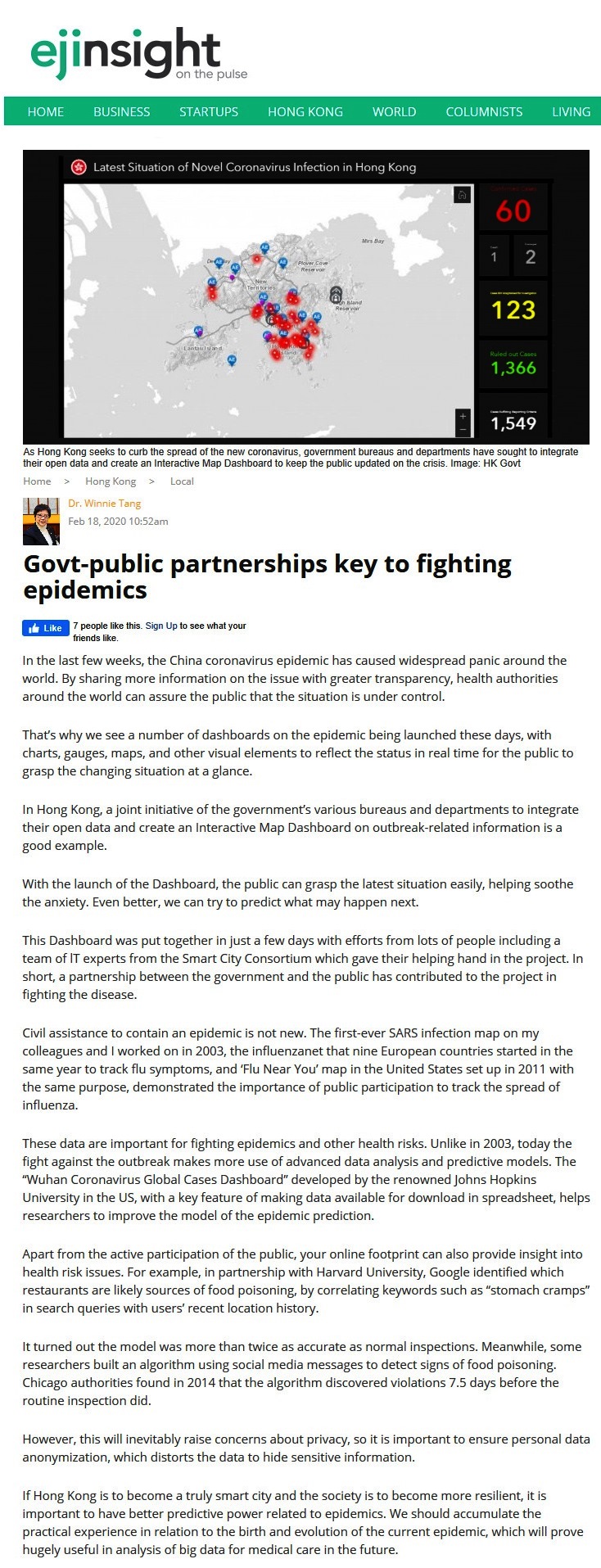網上版請按此

Govt-public partnerships key to fighting epidemics
In the last few weeks, the China coronavirus epidemic has caused widespread panic around the world. By sharing more information on the issue with greater transparency, health authorities around the world can assure the public that the situation is under control.
That's why we see a number of dashboards on the epidemic being launched these days, with charts, gauges, maps, and other visual elements to reflect the status in real time for the public to grasp the changing situation at a glance.
In Hong Kong, a joint initiative of the government's various bureaus and departments to integrate their open data and create an Interactive Map Dashboard on outbreak-related information is a good example.
With the launch of the Dashboard, the public can grasp the latest situation easily, helping soothe the anxiety. Even better, we can try to predict what may happen next.
This Dashboard was put together in just a few days with efforts from lots of people including a team of lT experts from the Smart City Consortium which gave their helping hand in the project. In short, a partnership between the government and the public has contributed to the project in fighting the disease.
Civil assistance to contain an epidemic is not new. The first-ever SARS infection map on my colleagues and I worked on in 2003, the influenzanet that nine European countries started in the same year to track flu symptoms, and 'Flu Near You' map in the United States set up in 2011 with the same purpose, demonstrated the importance of public participation to track the spread of influenza.
These data are important for fighting epidemics and other health risks. Unlike in 2003, today the fight against the outbreak makes more use of advanced data analysis and predictive models. The "Wuhan Coronavirus Global Cases Dashboard" developed by the renowned Johns Hopkins University in the US, with a key feature of making data available for download in spreadsheet, helps researchers to improve the model of the epidemic prediction.
Apart from the active participation of the public, your online footprint can also provide insight into health risk issues. For example, in partnership with Harvard University, Google identified which restaurants are likely sources of food poisoning, by correlating keywords such as "stomach cramps" in search queries with users' recent location history.
It turned out the model was more than twice as accurate as normal inspections. Meanwhile, some researchers built an algorithm using social media messages to detect signs of food poisoning. Chicago authorities found in 2014 that the algorithm discovered violations 7.5 days before the routine inspection did.
However, this will inevitably raise concerns about privacy, so it is important to ensure personal data anonymization, which distorts the data to hide sensitive information.
If Hong Kong is to become a truly smart city and the society is to become more resilient, it is important to have better predictive power related to epidemics. We should accumulate the practical experience in relation to the birth and evolution of the current epidemic, which will prove hugely useful in analysis of big data for medical care in the future.
Dr. Winnie Tang
Adjunct Professor, Department of Computer Science, Faculty of Engineering and Faculty of Architecture, The University of Hong Kong